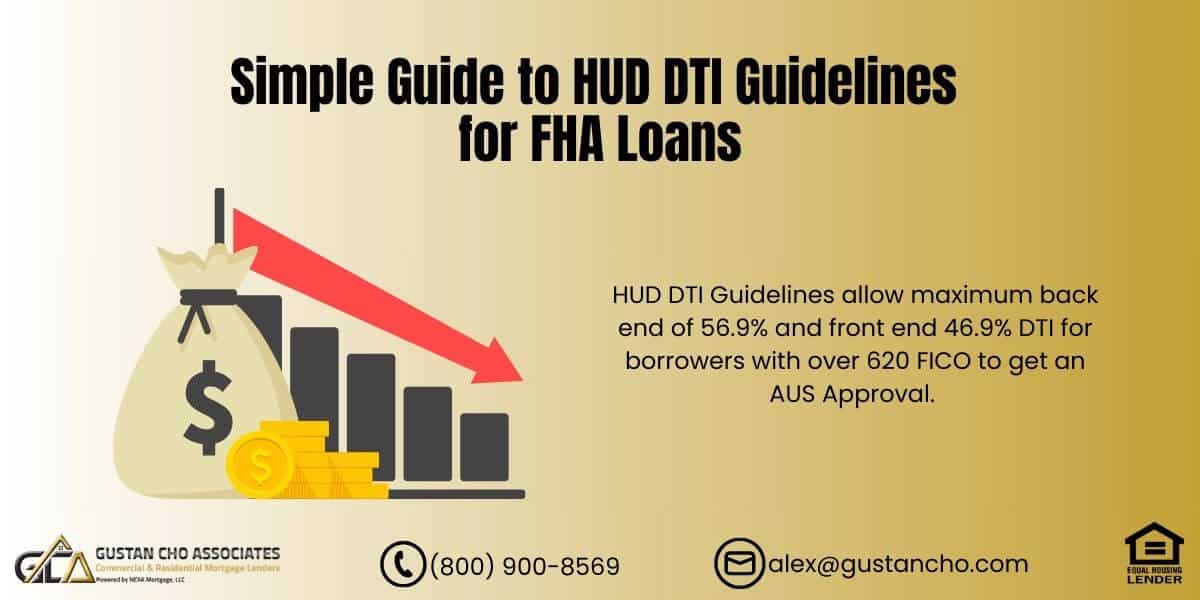Understanding HUD DTI Guidelines for FHA Loans in 2024: How to Qualify for a Purchase or Refinance
When you’re considering buying a home or refinancing, one term you’ll often hear is the DTI—or Debt-to-Income Ratio. If you’re considering obtaining an FHA loan supported by the Federal Housing Administration (FHA) under the supervision of HUD (U.S. Department of Housing and Urban Development), it’s important to understand HUD DTI guidelines in order to secure approval.
In this guide, we’ll break down the HUD DTI guidelines so that you can better understand how your debt impacts your chances of buying a home. Whether you’re planning a home purchase or a refinance, we’ll explain everything in easy terms and give you some helpful tips for qualifying, even if your DTI ratio is higher.
What Is the Debt-to-Income Ratio (DTI)?
Let’s start with the basics. Your debt-to-income ratio (DTI) compares the amount of money you owe each month to how much you earn. This ratio helps lenders determine if you’ll be able to handle a mortgage payment on top of your existing debts.
How DTI Is Calculated
To determine your DTI, sum up all of your debt payments monthly (such as car loans, credit cards, student loans, and the new mortgage payment you’re seeking), then divide that sum by your gross monthly income (your income before taxes and deductions).
Here’s an example:
- If your combined monthly obligations amount to $2,000 and your total monthly income is $5,000 before deductions, your debt-to-income ratio would be 40%.
- Formula: $2,000 ÷ $5,000 = 0.40 (or 40%).
Knowing your DTI ratio is essential for getting approved for an FHA loan. Let’s see how HUD DTI guidelines work for FHA loans.
Wondering How Your Debt-to-Income (DTI) Ratio Affects Your FHA Loan? Let’s Walk You Through the HUD Guidelines!
Contact us today to learn how your DTI affects your eligibility and get the help you need to qualify for an FHA loan.
2024 HUD DTI Guidelines for FHA Loans
As of 2024, HUD has set clear guidelines for how high your DTI ratio can be and still qualify for an FHA loan. However, not every lender follows HUD’s guidelines exactly—some have their own rules called lender overlays, which we’ll cover later.
Maximum DTI Ratios for FHA Loans
- For borrowers with 620 or higher credit scores:
- The maximum front-end DTI (housing-related debt like mortgage payments, taxes, and insurance) is 46.9%.
- The maximum back-end DTI (all monthly debts, including the new mortgage) is 56.9%.
- For borrowers with credit scores below 620:
- The maximum back-end DTI allowed is 43%.
- There is no specific cap on the front-end DTI, but many lenders set their own rules.
What does this mean for you? If your credit score is above 620, you have more flexibility with your debt than someone with a lower score. The higher your score, the more lenient lenders may be with your DTI ratio.
Why Do DTI Ratios Matter?
Lenders utilize DTI ratios to assess the level of financial risk you present. If your DTI ratio is too high, they may worry you’ll struggle to make your mortgage payments, especially if unexpected expenses arise.
But don’t worry—just because your DTI seems a little high doesn’t automatically disqualify you. Lenders also look at compensating factors that could work in your favor. We’ll get into those soon.
FHA Guidelines Versus Lender Overlays
While HUD sets the standard FHA guidelines, individual lenders often impose stricter rules known as lender overlays. These overlays can make qualifying harder, even if you technically meet HUD’s requirements.
What Are Lender Overlays?
A lender overlay is when a mortgage lender sets higher standards than the basic FHA guidelines.
An example is that HUD mandates a 580 credit score to qualify for an FHA loan with a 3.5% down payment. However, depending on their rules, some lenders may require a 620 or even 640 credit score.
This applies to DTI ratios too. HUD allows a maximum DTI of 56.9% for borrowers with a credit score of 620 or higher, but many lenders will set their own limits, capping DTI at 45% or 50%. If you’re told you don’t qualify due to a high DTI, it may just be the lender’s overlay, not HUD’s rules.
At Gustan Cho Associates, we don’t have these overlays. We follow HUD’s FHA guidelines strictly, so even if other lenders have turned you down, we may still be able to help.
Compensating Factors for High DTI Ratios
If your DTI ratio exceeds the standard guidelines, all hope is not lost! FHA loans allow for compensating factors that can help offset a higher DTI.
Here are some compensating factors that could improve your chances:
- Large cash reserves: Lenders might be more lenient if you have a lot of savings after closing.
- Proven rent history: If you’ve been making rent payments consistently, this shows you’re responsible.
- Higher income: This could be considered if you’ve recently had a salary increase.
- Minimal or no payment shock: If your new mortgage payment is not much higher than your current rent, this can work in your favor.
The key is working with a lender who understands how to present these compensating factors to give you the best chance at approval.
HUD DTI Guidelines for Manual Underwriting
What if you aren’t approved through the automated underwriting system (AUS)? You still have options with manual underwriting.
Manual Underwriting DTI Limits
- If your loan is manually underwritten (meaning a human reviews your file rather than a computer), the DTI caps can vary based on your compensating factors.
- Borrowers with strong compensating factors can sometimes qualify with DTI ratios exceeding 50% on manual underwriting.
This is great news if a lender has denied you because of DTI ratios, as manual underwriting may allow more flexibility.
How to Improve Your DTI Ratio Before Applying
If your DTI ratio is too high, there are steps you can take to improve it before applying for an FHA loan. Here are some practical tips:
- Pay Down Debt: Remember to concentrate on settling high-interest debts such as credit cards or personal loans. Lowering your monthly debt payments has the potential to decrease your DTI.
- Increase Your Income: Increasing your income, whether asking for a raise or taking on a side job, can lower your DTI ratio.
- Consolidate Your Debt: You can reduce your overall debt by combining high-interest debt into a loan with lower monthly payments.
- Hold Off on Big Purchases: Avoid taking on new debts before taking on a mortgage, like a car or personal loan. This could push your DTI ratio too high.
By taking these steps, you can improve your financial situation and potentially qualify for better loan terms.
Need Help Understanding HUD’s DTI Guidelines for FHA Loans? We’re Here to Help!
Contact us today to discuss HUD’s guidelines and how we can help you secure an FHA loan.
Common Mistakes That Can Increase Your DTI
When you’re working on improving your DTI, it’s important to avoid some common mistakes that can work against you:
- Co-signing on loans: If you co-sign for someone else’s loan, the full payment will count against your DTI, even if you aren’t making the payments.
- Ignoring small debts: Even small monthly payments, such as student loans or personal loans, add up. Paying off these small debts can help lower your overall DTI.
- Using credit cards irresponsibly: Before applying for a mortgage, try to minimize your credit card debt by keeping your balances low.
Being mindful of these mistakes can help keep your DTI ratio manageable and improve your chances of loan approval.
Ready to Apply? Here’s What to Do Next
If you’re ready to take the next step in purchasing or refinancing a home, here’s how you can prepare:
- Calculate Your DTI: To roughly assess your financial situation, begin by totaling all your monthly debts and then dividing that sum by your gross monthly income. This will give you a general understanding of where you stand.
- Check Your Credit Score
- Your DTI limits depend on your credit score. If your score is below 620, you’ll have stricter DTI requirements, while if your score is above 620, you’ll have more flexibility.
- Gather Your Documents
- Be prepared with documentation of your income (pay stubs, bank statements, and tax returns) and debts (credit card statements, loan documents).
Work with a Lender That Doesn’t Have Overlays
Some lenders make it harder to get approved with strict overlays. At Gustan Cho Associates, we follow the HUD guidelines without imposing extra requirements, which gives you a better shot at approval.
Conclusion: Qualify for an FHA Loan with HUD DTI Guidelines in 2024
Don’t let debt-to-income ratio concerns stop you from achieving your homeownership dreams. By understanding HUD’s DTI guidelines and working with a lender who doesn’t impose unnecessary overlays, you can increase your chances of getting approved for an FHA loan—whether purchasing or refinancing.
At Gustan Cho Associates, we specialize in helping borrowers who might not qualify elsewhere. Ready to see how we can help? Call us at 800-900-8569 or email us at gcho@gustancho.com. Our team is here every day of the week, even in the evenings and on weekends, to assist you with any inquiries and to help you navigate through the loan procedure.
Frequently Asked Questions About HUD DTI Guidelines:
Q: What is the Debt-to-Income (DTI) Ratio?
A: Your debt-to-income (DTI) ratio indicates the portion of your monthly earnings allocated to debt repayment, and financial institutions utilize this information to assess your ability to manage a mortgage.
Q: What are the HUD DTI Guidelines for FHA Loans in 2024?
A: For borrowers with a credit score of 620 or higher, HUD allows a front-end DTI of up to 46.9% and a back-end DTI of up to 56.9%. For scores below 620, the maximum back-end DTI is 43%.
Q: How Does DTI Affect my Ability to Get an FHA Loan?
A: Your debt-to-income (DTI) ratio holds significance as it indicates to lenders the portion of your income that is already allocated to debt. A high DTI poses challenges in qualifying for an FHA loan unless you possess additional compensating factors.
Q: What are the Compensating Factors for High DTI Ratios?
A: If your DTI is above the standard guidelines, lenders may still approve you if you have compensating factors like large cash reserves, a strong rent payment history, or a recent increase in income.
Q: What are Lender Overlays, and How do They Affect HUD DTI Guidelines?
A: Lender overlays are extra rules that individual lenders set on top of HUD DTI guidelines. For example, a lender may require a lower DTI ratio or higher credit score than HUD does.
Q: Can I Still Get an FHA Loan if my DTI Ratio is Too High?
A: If your DTI is too high, some lenders might allow manual underwriting, where compensating factors are considered, giving you more flexibility.
Q: How can I Improve My DTI Ratio to Qualify for an FHA Loan?
A: Paying off debt, boosting your earnings, or combining high-interest debts can reduce your DTI. Refrain from acquiring new debt before applying for a mortgage.
Q: What is the Difference Between Front-End and Back-End DTI?
A: Front-end DTI refers to housing-related debts like mortgage payments and insurance, while back-end DTI includes all monthly debts, such as credit cards and loans.
Q: What Happens if My Lender Rejects My FHA Loan Due to High DTI?
A: If a lender turns you down due to high DTI, it may be because of their overlay, not HUD’s rules. You can try applying with a lender like Gustan Cho Associates, which follows HUD guidelines without overlays.
Q: Why do some lenders set stricter DTI guidelines than HUD?
A: Lenders use stricter rules (overlays) to reduce risk. These guidelines go beyond HUD DTI guidelines and vary by lender, meaning you may qualify with one lender but not another.
This blog about the waiting period after foreclosure requirements for borrowers on title but not on mortgage was updated on October 11th, 2024.
Ready to Apply for an FHA Loan? Let’s Make Sure Your DTI Meets HUD’s Guidelines!
Contact us now to discuss your eligibility and start the application process.









